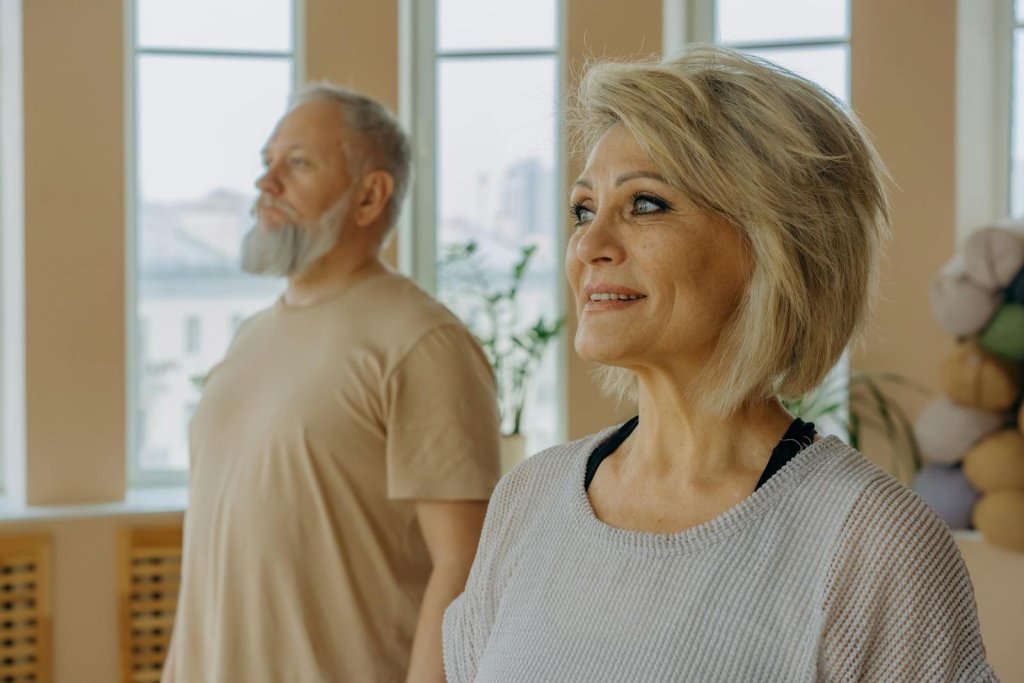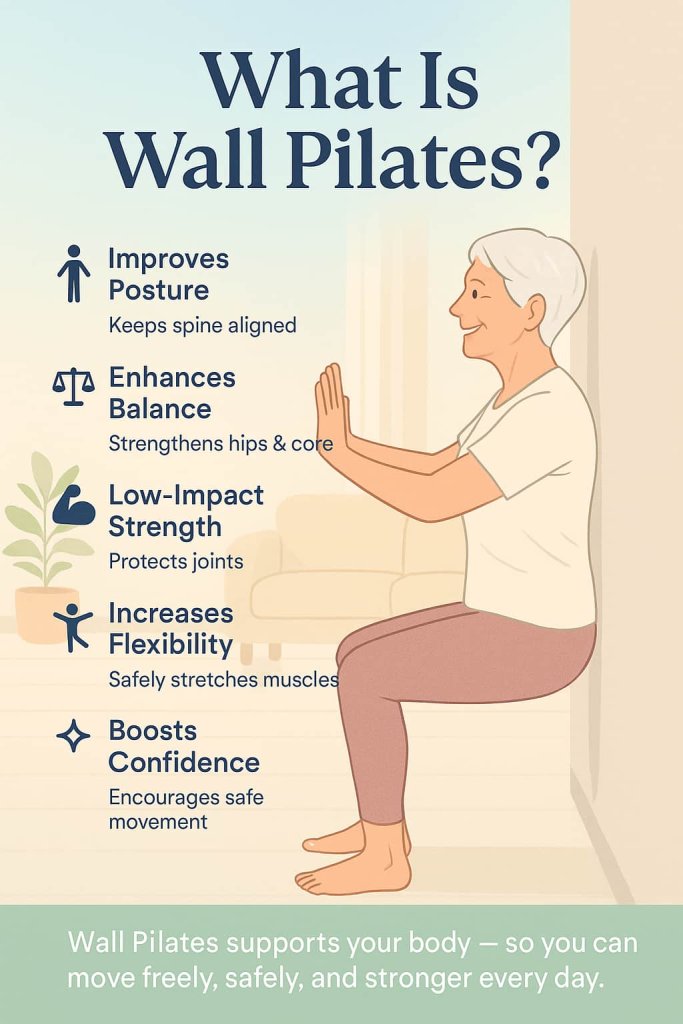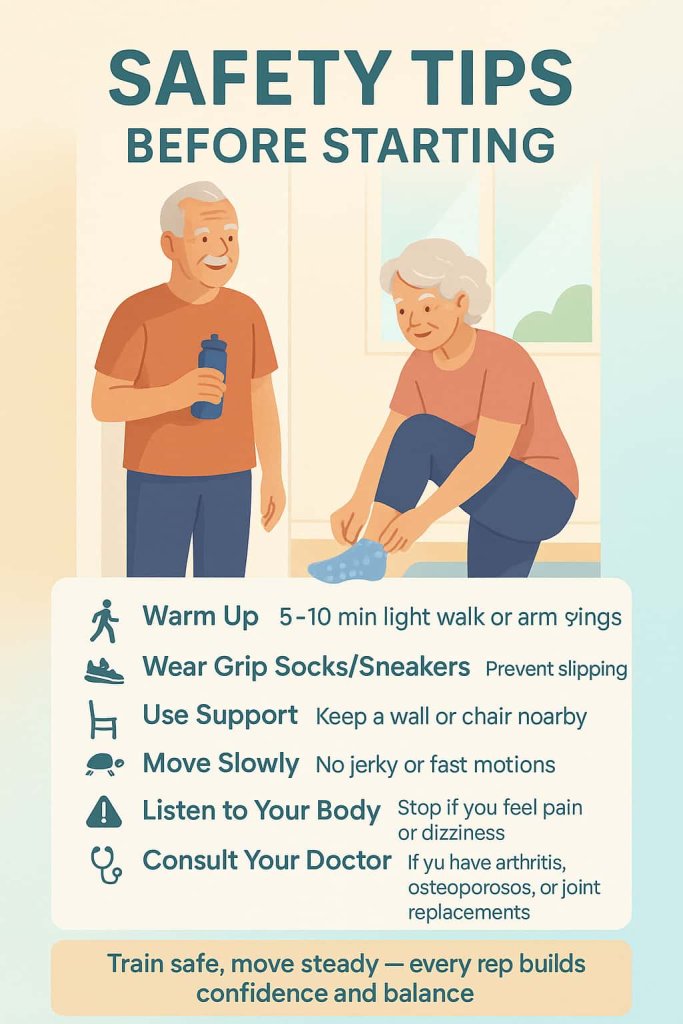Yes, seniors can safely do Wall Pilates — and it’s one of the best ways to improve strength, posture, and balance without strain.
Wall Pilates uses the wall as a support and alignment tool, allowing older adults to strengthen muscles, enhance flexibility, and reduce joint pressure. It’s gentle yet effective, ideal for beginners or anyone managing stiffness, arthritis, or low mobility.

In this guide, you’ll learn the 10 best Wall Pilates exercises for seniors, how they help your body, and safety tips to get started — no special equipment required, just a sturdy wall and a mat.
💡 The National Institute on Aging (2024) notes that balance and strength exercises — such as supported body-weight training like Wall Pilates — can improve stability and reduce fall risk (NIA.gov).
What Is Wall Pilates?
Wall Pilates is a low-impact version of traditional Pilates that uses the wall for support. The wall guides body alignment, prevents over-extension, and provides feedback during each move.

Benefits of Wall Pilates Exercises for Seniors
- Improves posture — keeps the spine aligned against the wall.
- Enhances balance — builds stabilizing muscles in hips and core.
- Low-impact strength — reduces joint stress.
- Increases flexibility — stretches tight muscles safely.
- Boosts confidence — helps seniors move comfortably without fear of falling.
🧠 A 2023 systematic review by Sampaio et al. found that Pilates training significantly improves balance, strength, and functional mobility in older adults — confirming its effectiveness for building glute, hip, and back stability essential for seniors (PubMed).
Safety Tips Before Starting

- Warm up 5–10 minutes (walk or arm swings).
- Wear non-slip socks or sneakers.
- Keep a sturdy wall or chair nearby.
- Move slowly — avoid jerky motions.
- Stop if you feel pain, dizziness, or tingling.
- If you have osteoporosis, arthritis, or joint replacements, consult your doctor first.
10 Best Wall Pilates Exercises for Seniors
Below are the best wall-supported Pilates moves chosen for core stability, balance, and total-body strength — all senior-friendly.
1. Wall Roll Down
Muscles worked: Core, spine stabilizers
Why it helps: Improves posture, spinal mobility, and releases back tension.
How to do:
- Stand with your back flat against a wall, feet hip-width apart.
- Take a deep breath in.
- As you exhale, slowly roll your spine down one vertebra at a time.
- Let your arms hang naturally and pause at the bottom.
- Slowly roll back up to standing.
Trainer Tip: Keep your core engaged and move slowly — think of “peeling” your spine off the wall.
🧘 Great for improving spinal health and reducing stiffness in the lower back.
2. Wall Push-Ups
Muscles worked: Chest, shoulders, arms
Why it helps: Strengthens upper body without floor strain or wrist pressure.
How to do:
- Stand facing a wall at arm’s length.
- Place your hands flat at shoulder height, slightly wider than shoulders.
- Bend elbows and lean chest toward the wall.
- Push back to start position.
Reps: 10–12 times
Trainer Tip: Keep body straight from head to heels; avoid arching your back.
💪 Perfect for maintaining shoulder and chest strength needed for daily tasks.
3. Wall Bridge Hold
Muscles worked: Glutes, hamstrings, core
Why it helps: Builds leg and hip strength for standing and walking stability.
How to do:
- Lie on your back near a wall with your feet flat on it.
- Press through your heels and lift hips off the floor.
- Hold for 3–5 seconds, then slowly lower down.
Reps: 8–10 times
Trainer Tip: Squeeze your glutes at the top — avoid arching your lower back.
🏋️ Supports better hip function and balance control.
4. Wall Leg Slides
Muscles worked: Quadriceps, hamstrings, glutes
Why it helps: Improves lower-body mobility and coordination.
How to do:
- Stand with your back against the wall, feet hip-width apart.
- Slide down slowly into a mini squat (knees over toes).
- Hold for 2–3 seconds, then slide back up.
Reps: 10–12 slides
Trainer Tip: Avoid going too deep — keep movements slow and controlled.
⚖️ Enhances leg endurance and supports balance for walking.
5. Wall Side Leg Lift
Muscles worked: Outer hips, glutes, core
Why it helps: Strengthens hip muscles, improving stability and side-to-side balance.
How to do:
- Stand sideways with one hand on the wall for support.
- Lift the outer leg out to the side slowly.
- Lower and repeat 10 times per side.
Trainer Tip: Keep upper body still — avoid leaning sideways.
🦵 Key exercise for reducing fall risk and supporting hip mobility.
6. Wall Chest Opener
Muscles worked: Chest, shoulders, upper back
Why it helps: Releases stiffness from rounded shoulders and improves posture.
How to do:
- Stand sideways next to a wall.
- Place your inside arm behind you, palm against the wall.
- Gently rotate your body away until you feel a stretch in the chest.
- Hold for 20–30 seconds, then switch sides.
Trainer Tip: Don’t overstretch — move until you feel a comfortable pull.
🧍 Perfect for anyone who spends long hours sitting or hunched forward.
7. Wall Plank (Standing)
Muscles worked: Core, shoulders, arms
Why it helps: Strengthens abdominal muscles without getting on the floor.
How to do:
- Place your forearms or palms on a wall at shoulder height.
- Step feet back so your body forms a straight line.
- Engage your core and hold for 20–30 seconds.
Trainer Tip: Keep breathing evenly — don’t hold your breath.
🔥 A safe and effective plank variation for seniors with joint sensitivity.
8. Wall Single-Leg Balance
Muscles worked: Glutes, core, ankles
Why it helps: Improves balance and coordination for fall prevention.
How to do:
- Stand near a wall with one hand lightly touching it.
- Lift one foot off the floor and balance for 10 seconds.
- Switch legs and repeat 5 times each.
Trainer Tip: Focus your gaze on a fixed point for better balance.
⚖️ Enhances stability and strengthens the muscles that support walking and standing.
9. Wall Side Bend Stretch
Muscles worked: Obliques, spine, shoulders
Why it helps: Improves flexibility and reduces stiffness along the side body.
How to do:
- Stand next to a wall, one hand resting on it.
- Raise your outside arm overhead.
- Gently lean toward the wall until you feel a side stretch.
- Hold for 15–20 seconds each side.
Trainer Tip: Avoid leaning forward — keep shoulders open.
🌿 A soothing finisher that eases tension and boosts mobility.
10. Wall Angel Stretch
Muscles worked: Shoulders, upper back, core
Why it helps: Improves posture, shoulder mobility, and reduces stiffness from rounded shoulders.
How to do:
- Stand with your back flat against the wall, feet about 6 inches away.
- Bend your elbows to 90 degrees (like a goalpost), pressing arms and hands into the wall.
- Slowly slide your arms upward as far as comfortable, keeping contact with the wall.
- Lower back down with control.
Reps: 10–12 slow repetitions
Trainer Tip: Keep your lower back and ribs pressed against the wall — avoid arching.
💡 Excellent for improving posture and reducing upper-back tightness common in older adults.
Additional Benefits of Wall Pilates
- Enhances blood circulation and joint mobility.
- Reduces low-back pain through controlled core activation.
- Improves coordination and body awareness.
- Encourages better breathing and stress management.
- Supports bone density (especially for post-menopausal women).
🧠 According to a 2024 Frontiers in Public Health review, older adults who performed low-impact resistance training had significant gains in strength and mobility.
Equipment You Might Use
While all exercises can be done with only a wall and mat, you can enhance your workout using:
| Equipment | Purpose |
|---|---|
| Resistance Band | Adds gentle resistance for arms/legs |
| Small Ball or Cushion | Improves alignment, core activation |
| Non-Slip Mat or Grip Socks | Prevents slipping |
| Chair Support | Helps balance for beginners |
Who Should Do Wall Pilates
Wall Pilates is ideal for:
- Seniors with joint pain or arthritis.
- Beginners returning to exercise.
- Adults recovering from mild injuries.
- Anyone wanting better posture and balance.
Who Should Avoid or Modify
- Those with severe osteoporosis (avoid deep forward bends).
- Anyone with vertigo or balance disorders — use chair support.
- People with uncontrolled heart conditions or joint replacements (doctor clearance first).
How to Start a Wall Pilates Routine After 60
- Begin with 10–15 minutes, 3 times per week.
- Focus on slow, controlled breathing throughout.
- Increase duration or add reps gradually.
- Track balance and flexibility progress monthly.
- Stay consistent — results build within 4–6 weeks.
FAQ — Wall Pilates for Seniors
1. Is Wall Pilates safe for seniors with arthritis?
Yes — its low-impact, joint-friendly movements help reduce stiffness. Check with your doctor before starting.
2. How often should I do Wall Pilates?
Aim for 3–5 sessions per week for best results.
3. Do I need equipment?
No. A wall and mat are enough. Resistance bands are optional.
4. Can Wall Pilates help with balance problems?
Yes — it builds core and stabilizer muscles to improve coordination and prevent falls.
5. How long until I see results?
Most seniors feel improved posture and flexibility within 3–4 weeks of consistent practice.
6. Is Wall Pilates good for weight loss?
Indirectly yes — it boosts muscle tone and mobility, which can increase daily activity and calorie burn.
7. Can I do it every day?
Light daily practice is fine if you alternate muscle focus and avoid fatigue.
Conclusion
Wall Pilates offers a safe, simple, and effective way for seniors to stay strong, flexible, and steady on their feet. By using the wall for support, you gain confidence to move without pain or fear of falling.
👉 Start today with 10 minutes of gentle Wall Pilates — your body will thank you with better balance, strength, and peace of mind.
References
- de Campos Júnior, J. F. et al. (2024). Effects of Pilates Exercises on Postural Balance in Older Adults: A Systematic Review.
Concludes that Pilates improves static and dynamic balance in older adults, though evidence strength varies.
PubMed - Li, F. et al. (2024). Effects of Pilates on Body Posture: A Systematic Review.
Shows Pilates enhances postural alignment and spinal stability, supporting your “posture & spinal alignment” section.
PMC – PubMed Central - National Institute on Aging (NIA). (2025). Exercise and Physical Activity for Older Adults [PDF brochure].
Provides practical guidance on exercise frequency, balance training, and safety tips for seniors.
order.nia.nih.gov
